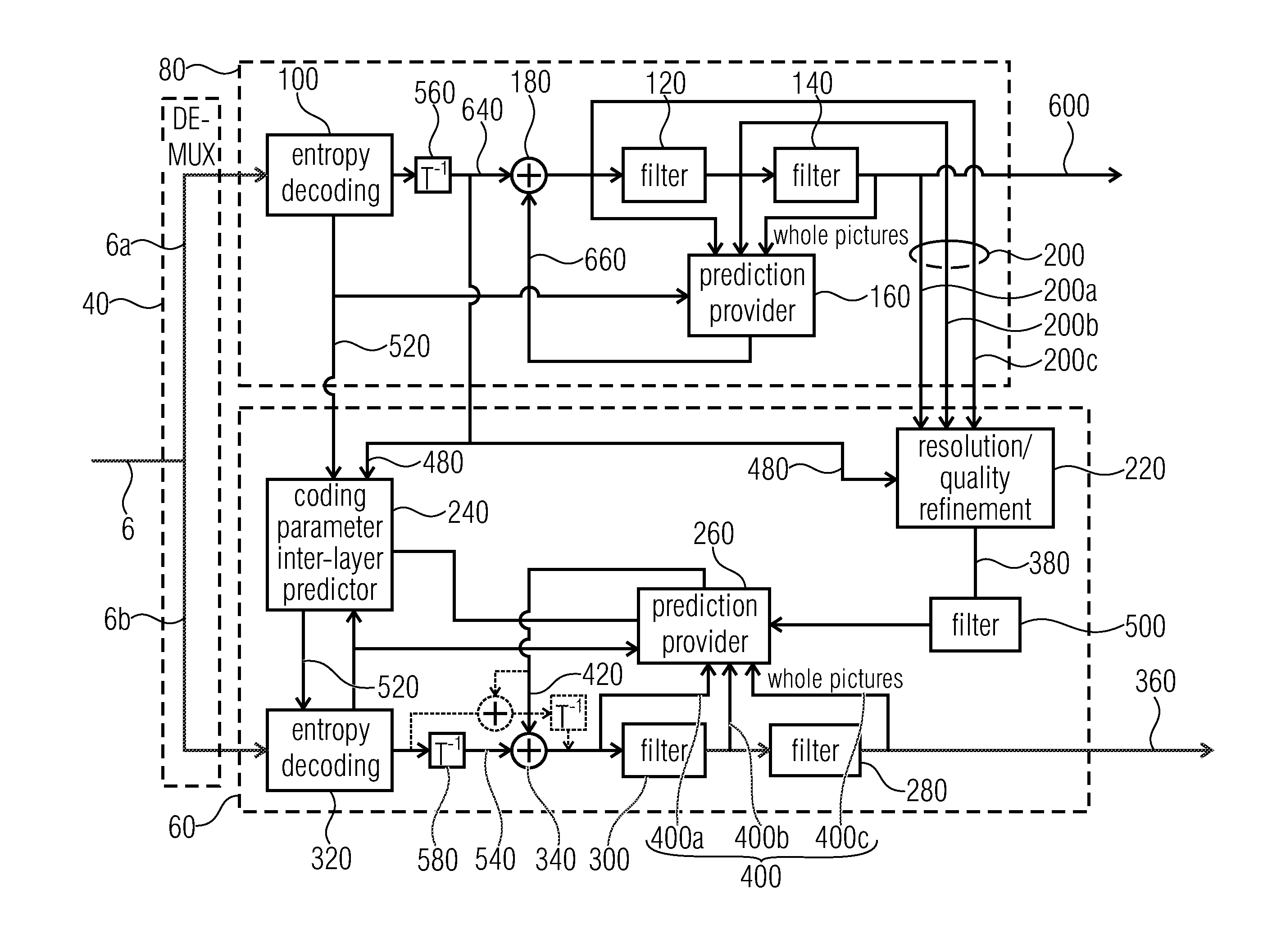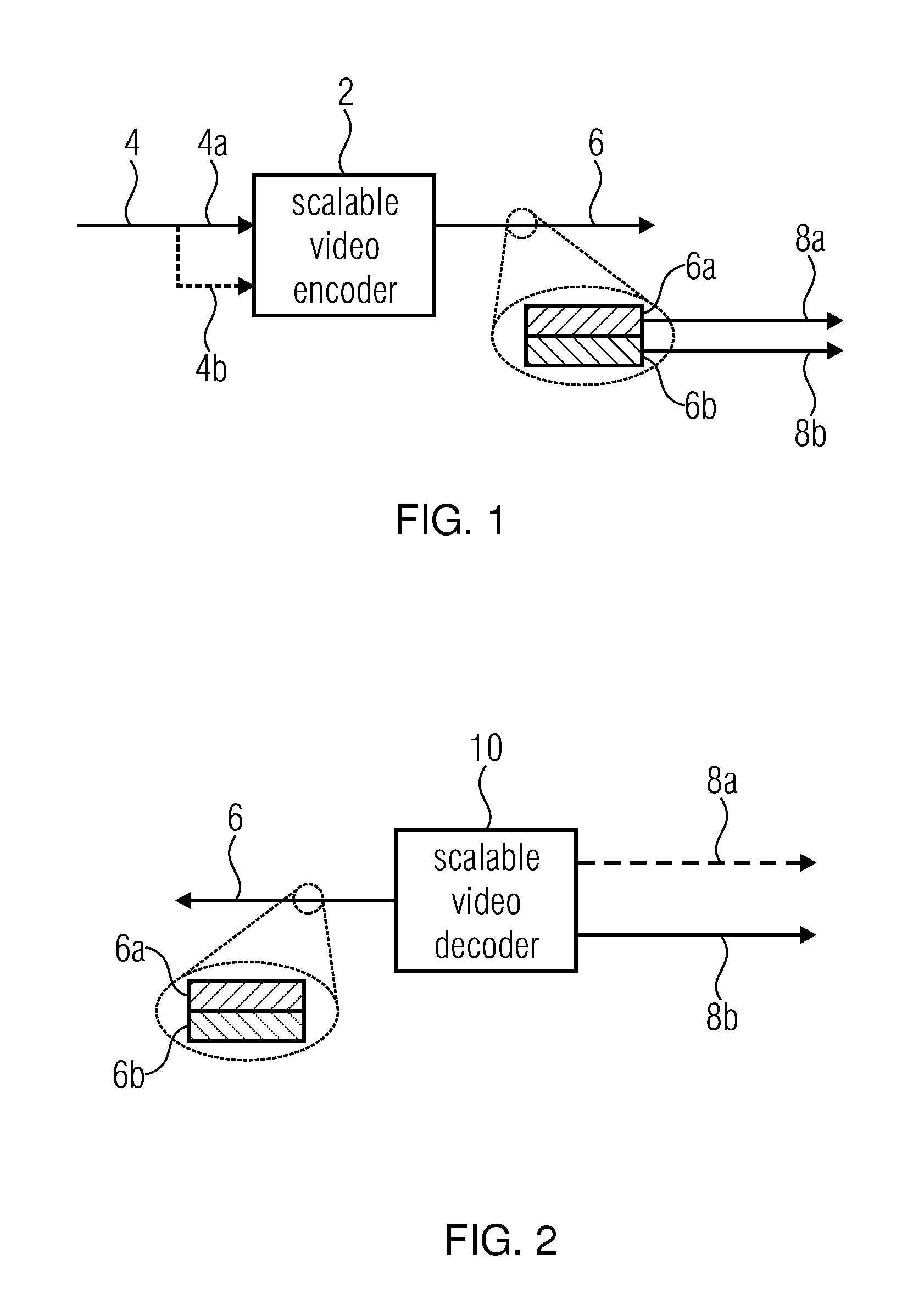[0025]One aspect of the present application is that information available from coding / decoding the base layer, i.e. base-layer hints, may be exploited to render the motion-compensated prediction of the enhancement layer more efficient by more efficiently coding the enhancement layer motion parameters. In particular, a set of motion parameter candidates gathered from neighboring already reconstructed blocks of the frame of the enhancement layer signal maybe enlarged by a set of one or more base layer motion parameters of a block of the base layer signal, co-located to the block of the frame of the enhancement layer signal, thereby improving the available quality of the motion parameter candidate set based on which the motion compensated prediction of the block of the enhancement layer signal may be performed by selecting one of the motion parameter candidates of the extended motion parameter candidate set and using the selected motion parameter candidate for the prediction. Additionally or alternatively, the motion parameter candidate list of an enhancement layer signal may be ordered dependent on base layer motion parameters involved in coding / decoding the base layer. By this measure, the probability distribution for selecting the enhancement layer motion parameter out of the ordered motion parameter candidate list is condensed so that, for example, an explicitly signaled index syntax element may be coded using less bits such as, for example, using entropy coding. Even further, additionally or alternatively, an index used in coding / decoding the base layer, may serve as a basis for determining the index into the motion parameter candidate list for the enhancement layer. By this measure, any signaling of the index for the enhancement layer may be avoided completely, or merely a deviation of the thus determined prediction for the index may be transmitted within the enhancement layer substream, thereby improving the coding efficiency.
[0026]One aspect of the present application is that a better predictor for predictively coding the enhancement layer signal in scalable video coding may be achieved by forming the enhancement layer prediction signal out of a inter-layer prediction signal and an enhancement layer internal prediction signal in a manner differently weighted for different spatial frequency components, i.e. by forming a weighted average of the inter-layer prediction signal and the enhancement layer internal prediction signal at a portion currently to be reconstructed to obtain an enhancement layer prediction signal such that the weights at which the inter-layer prediction signal and the enhancement layer internal prediction signal contribute to the enhancement layer prediction signal vary over different spatial frequency components. By this measure, it is feasible to construe the enhancement layer prediction signal from the inter-layer prediction signal and the enhancement layer internal prediction signal in a manner optimized with respect to spectral characteristics of the individual contribution components, i.e. the inter-layer prediction signal on the one hand and the enhancement layer internal prediction signal on the other hand. For example, owing to the resolution or quality refinement based on which the inter-layer prediction signal is obtained from a reconstructed base layer signal, the inter-layer prediction signal may be more accurate at lower frequencies than compared to higher frequencies. As far as the enhancement layer internal prediction signal is concerned, its characteristic may be the other way around, i.e. its accuracy may be increased for higher frequencies compared to lower frequencies. In this example, the inter-layer prediction signal's contribution to the enhancement layer prediction signal should, by respective weighting, exceed the enhancement layer internal prediction signal's contribution to the enhancement layer prediction signal in the lower frequencies and deceed the enhancement layer internal prediction signal's contribution to the enhancement layer prediction signal as far as the higher frequencies are concerned. By this measure, a more accurate enhancement layer prediction signal may be achieved, thereby increasing the coding efficiency and resulting in a higher compression rate.
[0028]One aspect of the present application is that scalable video coding may be rendered more efficient by deriving / selecting a subblock subdivision to be used for enhancement layer prediction, among a set of possible subblock subdivisions of an enhancement layer block by evaluating the spatial variation of the base layer coding parameters over the base layer signal. By this measure, less of the signalization overhead has to be spent on signaling this subblock subdivision within the enhancement layer data stream, if any. The subblock subdivision thus selected may be used in predictively coding / decoding the enhancement layer signal.
[0029]One aspect of the present application is that a subblock-based coding of transform coefficient blocks of the enhancement layer may be rendered more efficient if the subblock subdivision of the respective transform coefficient block is controlled on the basis of the base layer residual signal or the base layer signal. In particular, by exploiting the respective base layer hint, the subblocks may be made longer along a spatial frequency axis transverse to edge extensions observable from the base layer residual signal or the base layer signal. By this measure, it is feasible to adapt the subblocks' shape to an estimated distribution of the energy of the transform coefficients of the enhancement layer transform coefficient block in such a manner that, at an increased probability, each subblock will either be almost completely filled with significant, i.e. transform coefficients not having been quantized to zero, or with insignificant transform coefficients, i.e. only transform coefficients quantized to zero, while at a reduced probability any subblock has a similar number of significant transform coefficients on the one hand and insignificant transform coefficients on the other hand. Due to the fact, however, that subblocks having no significant transform coefficient may be signaled within the data stream efficiently, such as by use of merely one flag, and that subblocks almost completely filled with significant transform coefficients do not necessitate a waste of signalization amount for coding the insignificant transform coefficients which may be interspersed therein, the coding efficiency for coding the transform coefficient blocks of the enhancement layer is increased.
[0030]One aspect of the present application is that the coding efficiency of scalable video coding may be increased by substituting missing spatial intra prediction parameter candidates in a spatial neighborhood of a current block of the enhancement layer by use of intra prediction parameters of a co-located block of the base layer signal. By this measure, the coding efficiency for coding the spatial intra prediction parameters is increased due to the improved prediction quality of the set of intra prediction parameters of the enhancement layer, or, more precisely stated, the increased likelihood, that appropriate predictors for the intra prediction parameters for an intra predicted block of the enhancement layer are available thereby increasing the likelihood that the signaling of the intra prediction parameter of the respective enhancement layer block may be performed, on average, with less bits.
 Login to View More
Login to View More  Login to View More
Login to View More 


